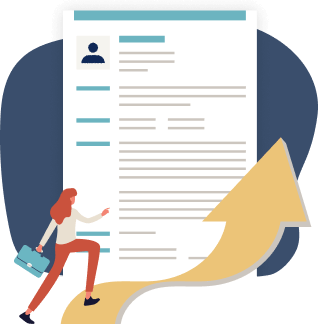Free Resume Templates
CREATE ON ANY DEVICE
Use a professionally designed ATS Friendly resume template & get noticed by recruiters, with a 42% higher response rate‡. Add pre-written content, customize, & download in Word or PDF. Easy on mobile & desktop.
Choose from 415 ATS friendly templates
Other ATS Friendly Resume Templates
Get Hired Fast With MyPerfectResume’s Free Resume Templates
Professional designs for any industry
From creative resume designs to minimalistic and basic resume templates, we’ve got an ATS friendly template for any job, industry, or career level.
Easy to customize for any experience level
Depending on your needs, you can customize the format of your resume template to highlight your skills, experience or education right from your mobile device or desktop.
Instant insights to boost your resume performance
With our ATS Resume Checker, you’ll get instant insights and actionable tips to strengthen your resume, increase your score, and stand out to hiring managers.
Expert tools to do the heavy lifting for you
MyPerfectResume’s Resume Builder and professional templates help you create a standout resume that recruiters will notice and hiring managers will love.
Search Professionally Written
Resume Examples
Easily tailor our resume examples using MyPerfectResume’s online Resume Builder.
Search Professionally Written
Cover Letter Examples
Our cover letter examples highlight the ideal tone and skills employers seek.
Search Professionally Written
CV Examples
Personalize our CV examples with MyPerfectResume’s free Resume Builder.
Get started creating a job-winning resume with professional templates
Upload your current resume
Import your details into one of our polished resume templates.
Create a new resume
Choose one of our resume templates and we’ll guide you through the rest.
FAQ
Last Updated:
Does MyPerfectResume have free resume templates?
Yes! MyPerfectResume now offers resume templates free to download to your mobile device or desktop right from this page. You’ll find a variety of professional designs in our template grid, and the ones available for free are clearly marked. Simply choose the template you like, download it instantly, and start customizing it to fit your career needs.
What is the best resume template?
The best resume template is one that is easy to read and tailored to your industry or skill level. Here are a few key features of standout resume templates:
- Professional design: A great resume template has a polished and professional design that catches the attention of employers or recruiters.
- Clean and uncluttered layout: A clean and uncluttered layout with well-organized sections helps focus attention on your core competencies and achievements.
- Customizable sections: Look for a template that allows you to easily customize and rearrange sections to highlight your most relevant skills, experience, and achievements.
- ATS formatting: Choose a template that follows applicant tracking system (ATS) guidelines to ensure your resume is parsed and scanned properly.
Remember to highlight your qualifications and match the specific job requirements. Select a resume template that complements your style and highlights your top qualities to recruiters. Then, you can customize it right from your mobile device.
Why should I use a resume template?
Using a resume template offers several advantages, especially if you want a polished resume without spending hours on formatting.
Here are some key reasons to consider using a resume template:
- Professional design: Templates provide clean, structured layouts that follow hiring standards, making your resume look polished and easy to read.
- Time-saving: With the design done for you, you can focus on adding your work experience and skills instead of worrying about layout.
- ATS-friendly: Our templates are designed with applicant tracking system (ATS) guidelines in mind, ensuring your resume is processed correctly.
- Consistent formatting: A template keeps fonts, headings, and spacing uniform, making your resume more organized and professional.
- Fewer errors: By following a template, you avoid common formatting mistakes that can distract employers.
Overall, a resume template can be a useful tool for improving your resume or creating a new one that stands out to employers.
Do you have free Microsoft Word resume templates?
Yes! MyPerfectResume offers free and premium Microsoft Word templates. Choose from professional, creative, modern, and simple resume template styles. You can easily tailor and download them right from your mobile device.
Do employers prefer one-page resume templates?
Employers typically spend only a few seconds scanning an individual’s resume, so we recommend sticking with a one-page resume if you can include all your most crucial job qualifications.
However, a two-page resume is acceptable if you’re applying for a job that favors extensive experience.
Whether you end up with one page or two, our resume templates have you covered with easily adjustable formatting available in our builder.
Do you have matching cover letter templates?
Yes, we design our cover letter templates to match our resume templates, ensuring consistency in job applications.
Remember that your cover letter should complement your resume, not simply repeat it. Touch on these points in your cover letter:
- Explain why you’re interested in the job and think you’re a good fit.
- Give more details about an achievement or skill you have that’s relevant to the job.
- Communicate your enthusiasm for the opportunity.
See our article on how to write a cover letter for step-by-step guidance for writing a compelling letter that impresses hiring managers.
When should I use a CV?
You should use a CV when applying for academic, research, medical, or international positions that require a detailed overview of your education, publications, and professional achievements.

Just three easy steps
- Select a template from our library of professional designs
- Build your resume with our industry-specific bullet points
- Download your resume and send!

Congratulations!
You've taken a big leap forward in your job search by choosing a resume template from MyPerfectResume.








